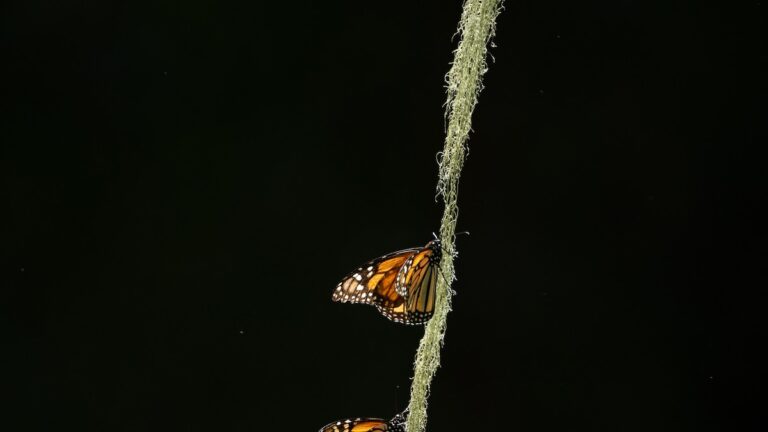In 2021 study, Zipkin and several colleagues analyzed more than 18,000 volunteer surveys of monarch butterflies conducted between 2004 and 2018. During those years, they found that weather conditions in the monarch's spring range were nearly five times more important than other factors combined to determine the size of the summer breeding population of the monarch. More extreme temperatures and rainfall in the spring meant smaller monarch populations in the summer.
In a later studyZipkin and postdoctoral student Erin Zylstra, now an ecologist at the Tucson Audubon Society in Arizona, used climate models to predict which counties in the U.S. Midwest and southern Canada are likely to offer the most tolerable breeding season climates for monarchs next year. 80 years.

Monarch butterflies are spotted at Fort Hood, Texas. Tagging insects helps biologists track their life cycle and migration routes.
THE POWER OF FLOWERS
Adult monarchs depend on milkweed plants to feed their larvae and nectar-producing flowers to fuel their long migrations. Zipkin says that individuals can help monarchs stave off climate change by growing more of these native plant species, and that larger-scale restoration efforts could be especially important in places like the potential climate havens she and Zylstra identified . “Planting milkweed in your garden is wonderful,” she says. “What we also want to think about is restoring native grasslands, because that can benefit not just monarchs but many different species.”
(Monarchs are actually toxic—and 5 other ways butterflies upset and surprise us.)
Milkweed thrives in disturbed areas and once grew abundantly on roadsides and farms throughout the US Midwest. In 1996, however, Monsanto began importing genetically modified “Roundup Ready” soybeans, corn, and other crops resistant to the herbicide glyphosate. Many farms began growing the stems and using glyphosate to control weeds, killing benign natives like milkweed in the process.
Karen Oberhauser, who recently retired as director of the University of Wisconsin-Madison Arboretum, teamed up with ecologist John Pleasants of the University of Iowa to analyze the implications of the glyphosate-resistant crop revolution for monarchs. They estimated that between 1999 and 2010, the availability of milk in the Midwest decreased by 58%., and monarch production in that region plummeted by 81 percent. The smallest population of monarchs migrating along the Pacific coast decreased by more than 90 percent during a similar period, possibly due to the effects of pesticides and growth in dairy farming availability.
Since the mid-2000s, milkweed loss due to glyphosate has leveled off, but milkweed remains dangerously rare in the Midwest and elsewhere. In a study published in 2017, Pleasants estimated that to reproduce at rates that would prevent extinction, North American monarchs would require at least doubling the amount of milkweed currently available in the Midwest. “Climate is now the most important driver of monarch populations, but the amount of available [milkweed] it still sets the ceiling,” says Oberhauser. “We can help monarchs by raising that cap.”

Volunteers from the Monarch Larva Monitoring Project – which has been running for over 30 years – check common milkweed strains for monarch butterfly eggs and caterpillars.
A shrink range
Monarchs can and do survive without migrating. South Florida is home to a year-round population of monarchs, and reports indicate that more monarchs are wintering in the Southeast, perhaps due to rising temperatures and increased year-round food availability. Monarch butterfly populations in Australia, New Zealand, Europe and elsewhere travel much shorter distances than their North American ancestors. “We've destroyed monarchs in places all over the world, and they've done just fine,” says Oberhauser.
But if climate change renders large parts of the monarch's North American range uninhabitable, forcing the continent's populations to significantly shorten their migrations or even remain stationary year-round, they will have much less breeding ground. Such a drastic reduction in their habitat could further shrink their already dwindling numbers.
(Everyone can help monarch butterflies. All you need is a yard.)

